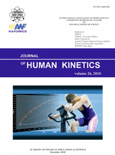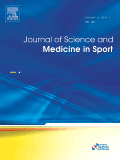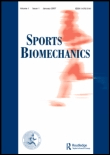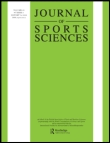
Journal of Human Kinetics
Scope & Guideline
Empowering professionals through open-access knowledge.
Introduction
Aims and Scopes
- Biomechanics and Kinematics:
Research in this area explores the mechanical aspects of human movement, including the analysis of motion, force application, and the biomechanical efficiency of various sports techniques. - Performance Analysis:
The journal publishes studies that assess and enhance performance metrics in athletes across a range of sports, including physiological testing, training interventions, and competition strategies. - Physical Training and Conditioning:
This scope includes research on training methodologies, recovery strategies, and conditioning programs designed to optimize athletic performance and minimize injury risks. - Psychological and Cognitive Aspects of Sport:
Investigations into the mental and emotional factors affecting sports performance, including focus, motivation, and decision-making processes in athletes. - Sport Nutrition and Health:
Articles in this category cover the impact of dietary practices, supplementation, and hydration on athletic performance and recovery. - Injury Prevention and Rehabilitation:
The journal addresses the prevention, assessment, and rehabilitation of sports-related injuries, focusing on evidence-based practices to enhance athlete safety. - Youth and Developmental Sports Science:
Research focused on the physical and psychological development of young athletes, addressing the unique training needs and performance characteristics of youth in sports.
Trending and Emerging
- Data-Driven Performance Analytics:
There is a growing trend towards using advanced analytics and technology, such as wearable devices and motion capture systems, to derive insights into performance and training effectiveness. - Psychological Resilience and Mental Skills Training:
Research focusing on mental toughness, coping strategies, and psychological interventions is gaining traction as athletes and coaches recognize the importance of mental preparation. - Injury Mechanisms and Prevention Strategies:
An increased emphasis on understanding the specific mechanisms behind sports injuries and developing targeted prevention strategies is becoming more prominent. - Nutrition and Recovery Innovations:
Emerging studies are exploring the role of nutrition, recovery modalities, and supplementation in enhancing athletic performance and recovery processes. - Youth Athlete Development Models:
There is a notable increase in research dedicated to optimizing the training and development of youth athletes, focusing on long-term athletic development frameworks. - Interdisciplinary Approaches in Sports Science:
Collaborative research that integrates insights from various disciplines—such as biomechanics, psychology, and nutrition—is on the rise, promoting a holistic understanding of athlete performance.
Declining or Waning
- Traditional Coaching Methods:
Research focusing on conventional coaching techniques has decreased, as there is a growing emphasis on innovative and evidence-based approaches to athlete development. - General Sports Medicine:
While still relevant, studies that cover broad topics in sports medicine without a specific focus on performance outcomes or training methodologies are becoming less frequent. - Historical Perspectives in Sports Science:
There has been a notable decline in papers that explore historical analyses of sports practices or traditional methods, with more emphasis now on contemporary and future-oriented research. - Non-Specific Exercise Interventions:
Research that does not target specific populations or sports contexts—such as generic exercise interventions—has waned in favor of more tailored and sport-specific studies.
Similar Journals

Sport Sciences for Health
Uncovering the Science Behind Athletic HealthSport Sciences for Health is a leading journal published by SPRINGERNATURE that aims to advance the understanding and application of sports science within healthcare contexts. Established in 2004, this journal has successfully provided a platform for innovative research and discussions in the fields of Orthopedics, Sports Medicine, and general Sports Science, achieving a commendable Q3 ranking in both categories as per the 2023 Scopus quartile rankings. With an active publication schedule through 2024, Sport Sciences for Health offers invaluable insights for researchers, professionals, and students who are eager to explore the intricate relationships between sport and health outcomes. This journal, set in Italy, encourages the dissemination of significant findings that can enhance athletic performance, rehabilitation strategies, and public health initiatives, fostering an integrative approach to both theory and practical applications in the realm of sport sciences.

JOURNAL OF SCIENCE AND MEDICINE IN SPORT
Transforming sports science through rigorous research.JOURNAL OF SCIENCE AND MEDICINE IN SPORT, published by Elsevier Science Ltd, is a premier academic journal based in the Netherlands that serves as a vital platform for disseminating cutting-edge research in the fields of sports medicine, orthopedics, and physical therapy. With an impressive Q1 categorization in Orthopedics and Sports Medicine, Physical Therapy, and Sports Science, this journal is recognized for its high-impact contributions and currently holds a significant rank in Scopus, positioned at #17 in Physical Therapy and #25 in Orthopedics. Spanning from 1998 to 2024, it provides scholars with rigorous peer-reviewed articles aimed at enhancing knowledge, practice, and research in sports and medicine. Although it does not offer open access, the journal remains essential for professionals, researchers, and students looking to stay ahead in these dynamic disciplines. By focusing on evidence-based practices and innovative methodologies, the JOURNAL OF SCIENCE AND MEDICINE IN SPORT continues to play a pivotal role in advancing the scientific understanding of health and performance in sports.

Sports Biomechanics
Transforming Injury Prevention with Cutting-Edge StudiesSports Biomechanics, a prominent journal published by ROUTLEDGE JOURNALS, TAYLOR & FRANCIS LTD, serves as a critical platform for researchers and professionals in the fields of orthopedics, sports medicine, and rehabilitation. With an ISSN of 1476-3141 and an E-ISSN of 1752-6116, this journal has been influential since its inception in 2002 and is set to continue making an impact until 2024. The journal holds respectable positions within various quartiles, specifically Q2 in Orthopedics and Sports Medicine, Q2 in Physical Therapy, Sports Therapy and Rehabilitation, and Q3 in Sports Science as of 2023. Its Scopus rankings further underscore its significance in the academic community, ranking 35th in Physical Therapy and 55th in Orthopedics. Although not an Open Access journal, Sports Biomechanics provides a robust forum for disseminating cutting-edge research that enhances the understanding of human movement, injury prevention, and the rehabilitation process, making it an invaluable resource for students, academics, and practitioners dedicated to advancing the science of sports biomechanics.

Biomedical Human Kinetics
Transforming Research into Movement SolutionsBiomedical Human Kinetics, an esteemed academic journal published by SCIENDO, focuses on the intricate intersections of human movement, rehabilitation, and the study of physical therapies. Since its transition to an open access model in 2009, this journal has become a vital platform for sharing groundbreaking research and innovative methodologies in the fields of Orthopedics, Sports Medicine, and Physical Therapy. With an ISSN of 0043-9630 and an E-ISSN of 2080-2234, it operates out of Poland, providing global access to high-quality research. The journal’s standing in 2023 is notable, ranking in the Q3 category for both Orthopedics and Sports Medicine and Physical Therapy, Sports Therapy, and Rehabilitation, reflecting its commitment to fostering academic discourse within these important and evolving domains. Furthermore, with Scopus rankings placing it in the 36th percentile in its categories, Biomedical Human Kinetics is recognized for its contributions to the academic community. As it converges research efforts from 2016 to 2024, this journal serves as a cornerstone for researchers, professionals, and students dedicated to enhancing human health and performance through informed scientific exploration.

Annals of Applied Sport Science
Pioneering Evidence-Based Practices in Sports ScienceThe Annals of Applied Sport Science, published by ANNALS APPLIED SPORT SCIENCE, is an esteemed open-access journal dedicated to advancing research in the fields of applied psychology, orthopedics, sports medicine, physical therapy, and social sciences related to sports and recreation. Launched in 2013, this journal aims to foster collaboration among researchers, practitioners, and educators by disseminating high-quality, peer-reviewed research that addresses contemporary issues in sports science and practices. Operating from Iran, the journal has demonstrated its significance by maintaining a strong presence in various academic rankings, including Q4 rank in Applied Psychology and Q3 ranks in Orthopedics and Sports Medicine, demonstrating its multidisciplinary approach. As it embarks on converging research from 2017 to 2024, the journal welcomes contributions that span innovative methodologies, evidence-based practices, and critical discussions that shape future perspectives in sports-related fields. With an accessible format, the Annals of Applied Sport Science is poised to make a lasting impact on its community of readers, including researchers, professionals, and students eager to engage with cutting-edge findings and trends.

Kinesiology
Empowering professionals with cutting-edge insights.Kinesiology is a leading academic journal published by UNIV ZAGREB, FAC KINESIOLOGY in Croatia, dedicated to advancing the fields of physical therapy, sports therapy, rehabilitation, and sports science. With an ISSN of 1331-1441 and E-ISSN of 1848-638X, this open-access journal, established in 2004, provides a platform for innovative research and practical applications, allowing wider accessibility and dissemination of knowledge. The journal holds a strong position in the academic community, boasting a 2023 categorization of Q2 in Physical Therapy, Sports Therapy and Rehabilitation, and Q3 in Sports Science, reflecting its significant impact and relevance within these fields. Researchers, professionals, and students benefit from its rigorous peer-reviewed articles that address contemporary challenges and breakthroughs. The dynamic scope of the journal spans from 2008 to 2024, ensuring the incorporation of cutting-edge studies while fostering a vibrant exchange of ideas amongst scholars. As an invaluable resource, Kinesiology connects a diverse audience, promoting the growth of knowledge in health professions and enhancing evidence-based practices in physical therapy and rehabilitation.

JOURNAL OF SPORTS SCIENCES
Pioneering research at the intersection of health and athletics.The JOURNAL OF SPORTS SCIENCES, published by TAYLOR & FRANCIS LTD, serves as a premier platform for disseminating influential research in the fields of sports science, orthopedics, and rehabilitation. With an impressive ISSN of 0264-0414 and E-ISSN of 1466-447X, this UK-based journal has established a significant presence in the academic community since its inception in 1983, continuing to thrive through 2024. It holds a coveted Q1 ranking across multiple disciplines including Orthopedics and Sports Medicine, and ranks 30th in Physical Therapy, showcasing its relevance and impact in the health professions sector. Although the journal does not currently offer open access, it remains a critical resource for researchers, professionals, and students dedicated to advancing knowledge and practice in sports sciences. The journal's commitment to publishing high-quality, peer-reviewed articles ensures that it remains at the forefront of innovation and discovery in sports-related health and rehabilitation.

European Journal of Human Movement
Elevating Standards in Physical Therapy ResearchThe European Journal of Human Movement, published by the University of Extremadura, Faculty of Sports Sciences in Spain, stands as a vital resource within the realms of Health, Physical Therapy, and Social Sciences. With its consistent commitment to Open Access since 2014, the journal facilitates the dissemination of high-quality research, fostering innovation and collaboration among scholars, practitioners, and students alike. The journal has carved out a niche in its categories, being ranked in the Q3 quartile across several fields, including Health (social science) and Physical Therapy, Sports Therapy, and Rehabilitation. With an ongoing publication timeline extending from 2019 to 2024, it aims to highlight contemporary issues, emerging trends, and groundbreaking studies within human movement sciences. Additionally, with its presence in the Scopus ranking and a determination to elevate research standards, the journal remains an essential platform for sharing knowledge and advancing professional practice in a rapidly evolving landscape.

SCANDINAVIAN JOURNAL OF MEDICINE & SCIENCE IN SPORTS
Exploring New Frontiers in Orthopedics and Physical Therapy.SCANDINAVIAN JOURNAL OF MEDICINE & SCIENCE IN SPORTS, published by Wiley, stands at the forefront of research in the fields of orthopedics, sports medicine, and physical therapy. Established in 1991, this prestigious journal has built a strong reputation, reflected in its Q1 ranking across multiple categories including Orthopedics and Sports Medicine, and Physical Therapy and Rehabilitation, as of 2023. With a discerning focus on innovative research and practical applications, the journal publishes high-quality studies that advance the understanding of sports performance and rehabilitation strategies. Although it does not offer open access, it remains accessible through various institutional subscriptions, ensuring that both practitioners and academics can benefit from its findings. The journal's commitment to excellence is further evidenced by its impressive Scopus rankings, placing it in the top 94th percentile within its respective fields. As the athletic landscape continues to evolve, SCANDINAVIAN JOURNAL OF MEDICINE & SCIENCE IN SPORTS serves as an essential resource for researchers, clinicians, and students dedicated to improving health outcomes in sports and exercise.

MEDICINA DELLO SPORT
Connecting Academia and Practice in Sports MedicineMEDICINA DELLO SPORT is a distinguished journal published by EDIZIONI MINERVA MEDICA, dedicated to advancing knowledge in orthopedics, sports medicine, and physical therapy. With its ISSN 0025-7826 and E-ISSN 1827-1863, this journal has been a pivotal platform for scholarly research since its inception in 1965, enhancing the understanding of various aspects of sports health and rehabilitation. Although it currently does not offer open access, it maintains a reputable stance in academic publishing, ranking in Q3 for both Orthopedics and Sports Medicine as well as Physical Therapy, Sports Therapy, and Rehabilitation, according to the latest metrics. With its inclusion in Scopus and a strong presence in important health professions, MEDICINA DELLO SPORT is crucial for researchers, professionals, and students aiming to explore and contribute to the evolving field of sports medicine and therapies. It is published from its headquarters located at CORSO BRAMANTE 83-85 INT JOURNALS DEPT., 10126 TURIN, ITALY, ensuring a European perspective in global health discussions.